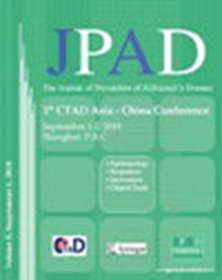Mediterranean Diet and Magnetic Resonance Imaging-Assessed Brain Atrophy in Cognitively Normal Individuals at Risk for Alzheimer's Disease.
IF 7.8
3区 医学
Q1 CLINICAL NEUROLOGY
引用次数: 120
Abstract
OBJECTIVES Epidemiological evidence linking diet, one of the most important modifiable environmental factors, and risk of Alzheimer's disease (AD) is rapidly increasing. Several studies have shown that higher adherence to a Mediterranean diet (MeDi) is associated with reduced risk of AD. This study examines the associations between high vs. lower adherence to a MeDi and structural MRI-based brain atrophy in key regions for AD in cognitively normal (NL) individuals with and without risk factors for AD. DESIGN Cross-sectional study. SETTING Manhattan (broader area). PARTICIPANTS Fifty-two NL individuals (age 54+12 y, 70% women) with complete dietary information and cross-sectional, 3D T1-weighted MRI scans were examined. MEASUREMENTS Subjects were dichotomized into those showing higher vs. lower adherences to the MeDi using published protocols. Estimates of cortical thickness for entorhinal cortex (EC), inferior parietal lobe, middle temporal gyrus, orbitofrontal cortex (OFC) and posterior cingulate cortex (PCC) were obtained by use of automated segmentation tools (FreeSurfer). Multivariate general linear models and linear regressions assessed the associations of MeDi with MRI measures. RESULTS Of the 52 participants, 20 (39%) showed higher MeDi adherence (MeDi+) and 32 (61%) showed lower adherence (MeDi-). Groups were comparable for clinical, neuropsychological measures, presence of a family history of AD (FH), and frequency of Apolipoprotein E (APOE) ε4 genotype. With and without controlling for age and total intracranial volume, MeDi+ subjects showed greater thickness of AD-vulnerable ROIs as compared to MeDi- subjects (Wilk's Lambda p=0.026). Group differences were most pronounced in OFC (p=0.001), EC (p=0.03) and PCC (p=0.04) of the left hemisphere. Adjusting for gender, education, FH, APOE status, BMI, insulin resistance scores and presence of hypertension did not attenuate the relationship. CONCLUSION NL individuals showing lower adherence to the MeDi had cortical thinning in the same brain regions as clinical AD patients compared to those showing higher adherence. These data indicate that the MeDi may have a protective effect against tissue loss, and suggest that dietary interventions may play a role in the prevention of AD.地中海饮食和磁共振成像评估阿尔茨海默病风险认知正常个体的脑萎缩
目的流行病学证据表明,饮食是最重要的可改变环境因素之一,与阿尔茨海默病(AD)的风险正在迅速增加。几项研究表明,坚持地中海饮食(MeDi)与降低AD风险有关。本研究探讨了认知正常(NL)个体中存在或不存在AD危险因素的AD关键区域的高依从性与低依从性与基于结构mri的脑萎缩之间的关系。DESIGNCross-sectional研究。曼哈顿(更广阔的区域)。参与者52名NL个体(年龄54+12岁,70%为女性)具有完整的饮食信息和横断面3D t1加权MRI扫描。采用已公布的方案,将受试者分为高依从性和低依从性两组。使用自动分割工具(FreeSurfer)获得内鼻皮质(EC)、下顶叶、颞中回、眶额皮质(OFC)和后扣带回皮质(PCC)的皮质厚度估计。多元一般线性模型和线性回归评估了MeDi与MRI测量的关系。结果52例患者中,20例(39%)表现出较高的依从性(MeDi+), 32例(61%)表现出较低的依从性(MeDi-)。两组在临床、神经心理、AD家族史(FH)和载脂蛋白E (APOE) ε4基因型频率方面具有可比性。无论是否控制年龄和总颅内容积,与MeDi-受试者相比,MeDi+受试者ad易损roi的厚度更大(Wilk’s Lambda p=0.026)。左半球OFC (p=0.001)、EC (p=0.03)和PCC (p=0.04)组间差异最为显著。调整性别、教育程度、FH、APOE状态、BMI、胰岛素抵抗评分和是否存在高血压并没有减弱这种关系。结论:与依从性较高的患者相比,依从性较低的患者在与临床AD患者相同的大脑区域皮质变薄。这些数据表明,MeDi可能对组织损失具有保护作用,并提示饮食干预可能在预防AD中发挥作用。
本文章由计算机程序翻译,如有差异,请以英文原文为准。
求助全文
约1分钟内获得全文
求助全文
来源期刊

Jpad-Journal of Prevention of Alzheimers Disease
CLINICAL NEUROLOGY-
自引率
7.80%
发文量
85
期刊介绍:
The JPAD « Journal of Prevention of Alzheimer’Disease » will publish reviews, original research articles and short reports to improve our knowledge in the field of Alzheimer prevention including : neurosciences, biomarkers, imaging, epidemiology, public health, physical cognitive exercise, nutrition, risk and protective factors, drug development, trials design, and heath economic outcomes.
JPAD will publish also the meeting abstracts from Clinical Trial on Alzheimer Disease (CTAD) and will be distributed both in paper and online version worldwide.
 求助内容:
求助内容: 应助结果提醒方式:
应助结果提醒方式:


